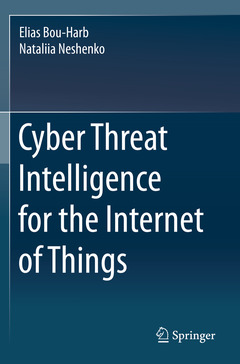Description
Cyber Threat Intelligence for the Internet of Things, 1st ed. 2020
Authors: Bou-Harb Elias, Neshenko Nataliia
Language: English
Subject for Cyber Threat Intelligence for the Internet of Things:
158.24 €
In Print (Delivery period: 15 days).
Add to cartPublication date: 05-2021
Support: Print on demand
158.24 €
In Print (Delivery period: 15 days).
Add to cartPublication date: 05-2020
89 p. · 15.5x23.5 cm · Hardback
Description
/li>Contents
/li>Biography
/li>Comment
/li>
Introduces a unique taxonomy by emphasizing and discussing IoT vulnerabilities in the context of various, previously unanalyzed dimensions
Proposes and evaluates an innovative approach to infer, characterize and attribute unsolicited Internet-scale IoT devices by correlating passive and the results of active empirical measurements
Presents a web-based platform, which is capable of aggregating data from multiple sources and promptly generating relevant intelligence, while requiring minimal human interaction
Reports the alarming number of compromised IoT devices related to smart home appliances, critical infrastructure, and automated control sectors




